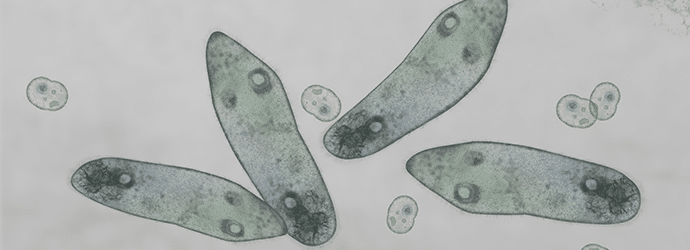The lac operon is an amazing tool in molecular biology. It has been used for decades to turn on protein expression in an inducible manner with IPTG. The result is synthesis of vast amounts of protein to be used as you wish.
While the lac operon is an amazing tool for protein production, it is also being increasingly used as an amazing microscopy tool.
Brief lac operon refresher – only the important parts
The bacterial lac operon includes a handful of genes, a promoter sequence and, importantly, an operator sequence (lacO), where a transcription factor can bind. The transcription factor is lacI, which functions as a repressor, binding tightly to the operator and preventing transcription of downstream genes (Figure 1). lacI, in E. coli, is upstream of the operator sequence and is transcribed constitutively. In the presence of lactose, a lactose metabolite binds to lacI causing it to disassociate from the operator sequences and induce expression of genes in the lac operon. Alternatively, exogenously supplied IPTG can also bind lacI, causing derepression.
To use the lac operon as a microscopy tool, all we care about is that lacI binds tightly to the specific operator sequence.
Enjoying this article? Get hard-won lab wisdom like this delivered to your inbox 3x a week.

Join over 65,000 fellow researchers saving time, reducing stress, and seeing their experiments succeed. Unsubscribe anytime.
Next issue goes out tomorrow; don’t miss it.
The lac operon as a microscopy tool
The problem
In 1996, Aaron Straight and colleagues wanted to look at a single chromosome’s centromere(s) over time in Saccharomyces cerevisiae. At that time, the typical thing to do to observe centromeres in yeast was to make fluorescent fusion proteins of the modified histone Cse4p (= CENPA in humans) and GFP.
But this labels all centromeres, and due to budding yeast’s small size, the centromeres all appear together as a single fluorescent spot and cannot be individually resolved.
The solution
Straight et al., turned to the lac operon to solve this problem. They figured that they could stick the operator sequence from the lac operon into the yeast genome, near one, specific centromere, and also fuse the lac repressor (lacI) to a fluorescent protein (e.g. GFP). When combined, the lacI-GFP would light up only the one chromosome by binding specifically to the operator sequence (Figure 2; See Straight, et al, 1996 for the hairy details).
It worked! For the first time, researchers were able to see one specific location on one chromosome in budding yeast as a nice, bright green spot that separated into two spots during mitosis.
Not only was the technique visually stunning, but it also allowed them to learn a considerable amount about how sister chromatids separate (or don’t) under various conditions. Also, the novel technique caused it to become a landmark paper, cited >400 times so far and resulting in many interesting uses and extensions.

What else can you do with this method?
1. Put the lacO sequences at different loci of interest to see how their territories and motion differ. For example, put lacO sequences near centromeres, telomeres, or origins of replication (Heun et al. 2001).
2. Add in a second bacterial operon system to watch two chromosomal loci simultaneously in two colors: The Tet operon functions similarly to the lac operon. If you insert a lacO sequence near one centromere, a tetO sequence near another, and then express lacI-GFP and TetR-RFP, you can watch two pairs of centromeres simultaneously, even though they crowd into a very small space (Stephens et al. 2013).
3. Bind things besides GFP to lacI to force their localization to the chromosomal locus where you’ve inserted the lac operon. For example, you could make a triple fusion protein of GFP-Scc1-lacI, then insert lacO somewhere interesting, like near a centromere. Scc1 is part of the cohesin complex, which holds together sister chromatids until anaphase. It gets cleaved by separase, and so by watching when your GFP dot goes away, which happens when it is no longer attached to the chromosome through Scc1-LacI, you can learn precisely when separase acts at particular loci on a chromosome. (Yaakov et al. 2012).
The possibilities are endless!
References:
Straight et al. 1996 “GFP tagging of budding yeast chromosomes reveals that protein-protein interactions can mediate sister chromatid cohesion” Current Biology 6(12) 1599-1608.
Heun et al. 2001 “Chromosome dynamics in the yeast interphase nucleus” Science 294(5549): 2181-2186.
Yaakov et al. 2012 “Separase Biosensor Reveals that Cohesin Cleavage Timing Depends on Phosphatase PP2ACdc55 Regulation” Developmental Cell 21(1):124-136.
Stephens et al. 2013 “Pericentric chromatin loops function as a nonlinear spring in mitotic force balance” Journal of Cell Biology 200(6):757-772.
You made it to the end—nice work! If you’re the kind of scientist who likes figuring things out without wasting half a day on trial and error, you’ll love our newsletter. Get 3 quick reads a week, packed with hard-won lab wisdom. Join FREE here.









